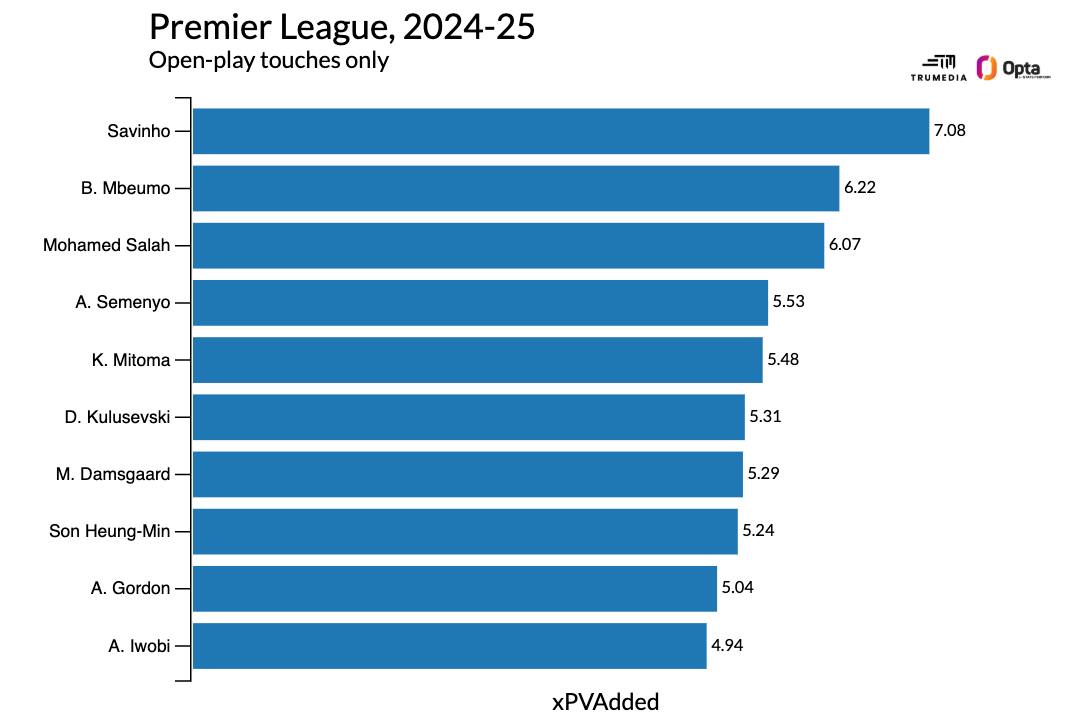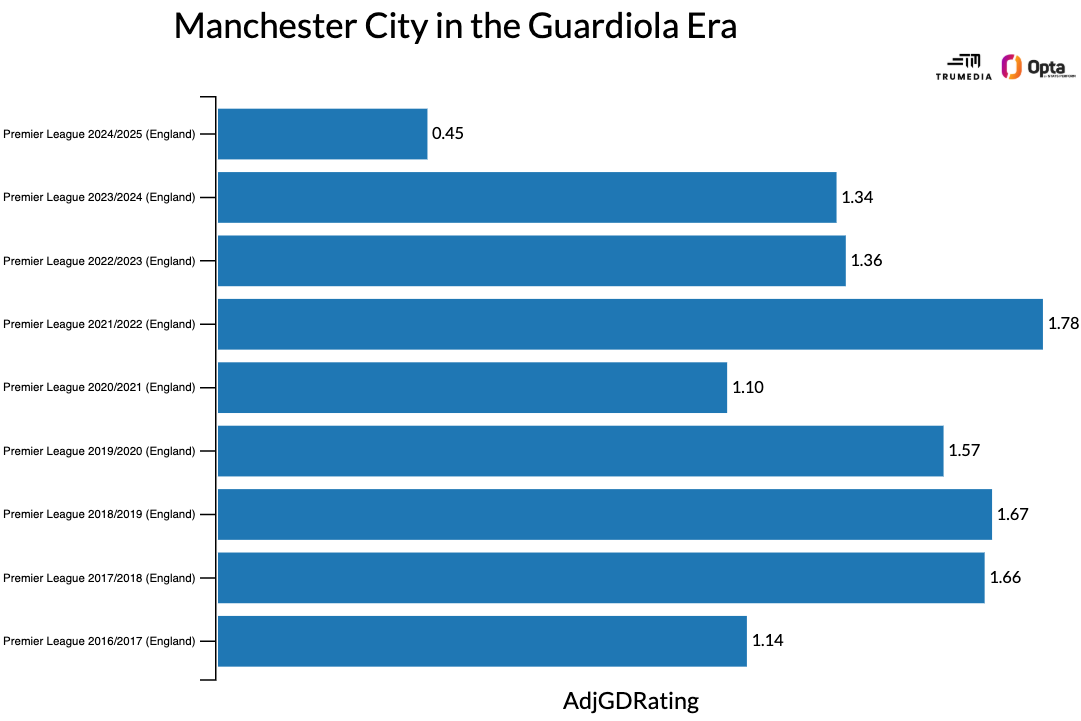Judging Man City’s transfer window signings over the past 3 years
Stevie Nicol and Craig Burley analyze what’s to blame for Phil Foden’s down season for Manchester City. (1:55)
Manchester City are broken.
It’s late March, we keep waiting for them to turn the corner, and it hasn’t happened.
This collection of players, as managed by Pep Guardiola, can’t consistently play at a high level. They’ve had stretches when they’ve found enjoyment by scoring goals, but then provided even more joy to their opponents on the other end. More recently, it has been really hard to score against them but even harder for them to score against opponents.
One way to look at this, on a broader scale, is that it’s the end of an era. City won four straight Premier League titles. They won the treble in 2023. They’ve won the league in six of the past seven seasons. And their average point total across those title-winning campaigns was 93 points. Only three other teams in the history of the Premier League have accumulated more than 93 points — in a season.
To be that dominant, during the height of the Premier League’s global financial dominance, you might think they would have to sacrifice the future. If they cared about the long term, then they couldn’t average 93 points per title-winning season because that can’t happen without doing everything to maximize the here and now. Except, that’s not how it works when City is backed by comparatively unlimited funding.
• Live on ESPN+:Man City vs. Bournemouth, FA Cup (Sunday 11:30 a.m. ET)
Since summer 2022, Manchester City have signed 18 new players. They’ve tried to win now and keep winning in the future. But beyond the injuries and aging club stalwarts, the biggest explanation for City’s struggles this season is that they’ve signed the wrong players. When too many signings are flops, it will catch up with you.
So, ahead of the FA Cup quarterfinals featuring Man City — live on ESPN+ this Saturday and Sunday — let’s look at those 18 signings. We’ll look at their ages and fees at the time of the transfers, group them by type, and then we’ll see if we can figure out where, and how, it went wrong.
Lots of money for high-risk midfielders
Kalvin Phillips, 26, midfielder: €49 million from Leeds United
Matheus Nunes, 25, midfielder: €62 million from Wolverhampton
City haven’t attacked and defended well at the same time, suggesting the team’s issues don’t stem from the defense or the attack, but the area of the field that connects the two. And City’s struggles in midfield stem from spending nearly over €110 million in transfer fees on two midfielders who are incapable of playing midfield for Manchester City.
And neither player was particularly young. Phillips is 29, and Nunes will be 27 at the start of next season. If these were promising 21-year-olds, sure, but both players needed to be immediate contributors, and neither one has come close to that.
Guardiola is perhaps the pickiest manager when selecting his midfielders, and I struggle to see the vision for either player.
Phillips was a good passer and a fantastic ball-winner with Leeds, but he was playing in a different system from the stranglehold control Guardiola implemented at City. In the 2021-22 season, Leeds averaged 103 possessions in their matches, while City averaged 83. Those respective numbers were the most and the fewest in the league.
That’s not to say players can’t play in different systems, but isn’t the point of having Manchester City money so that you don’t need to play the projection game?
This applies even more to the Nunes move. The similar-player algorithm on the site FBref isn’t a universal source of truth, but in his final season at Wolves, Nunes’s most-similar players were Crystal Palace‘s Jeffrey Schlupp and Aston Villa‘s John McGinn.
Nunes was a decent ball-carrier, but he didn’t impact games in any other way. At best, he was a bet on athleticism. This season in the Premier League, he has recorded the highest max speed (34.19 kilometers per hour, per PFF FC) among all midfielders, except he has had little to no impact on winning.
These were both signings where a coach envisions everything a player can do, instead of the things we’ve seen him do. But Manchester City don’t need to be in the business of projection — especially not for more than €100 million in transfer fees.
Even more money on high-risk prospects
Josko Gvardiol, 21, defender: €90 million from RB Leipzig
Jérémy Doku, 21, winger: €60 million from Rennes
I had Josko Gvardiol in my top 10 ranking of the best players in the Premier League.
As the sport has increasingly prioritized hybrid defenders — bigger fullbacks who are comfortable out wide and can slide infield as a third center back or an extra midfielder — Gvardiol has developed into perhaps the modern ideal. He’s big, fast, has a ton of center back experience … and yet he’s also producing on the ball as if he’s a traditional left fullback.
This move panned out — he has been City’s best player this season — but it still represented a sizable risk. Defending in the Bundesliga is a lot different from defending in the Premier League. City, whether planned or not, changed Gvardiol’s position. They also paid more in transfer fees for him than all but one other player in the club’s history (Jack Grealish).
A move that still hasn’t panned out, though: the €60 million for Jeremy Doku.
Think of the wingers or wide players whom Guardiola has relied on during his career: Lionel Messi, Pedro, David Villa, Thierry Henry, Franck Ribery, Arjen Robben, Leroy Sané, Raheem Sterling, Riyad Mahrez. These are all players who did a ton of damage in and around the penalty area. They all were either masters of off-ball movement, world-class passers, or incredible shot-getters.
When City signed him, Doku had shown one world-class skill — carrying the ball — and that remains the case after two seasons in the Premier League. But it’s still unclear just how valuable that skill is. Though City have always moved the ball more slowly than everyone else, they still seemed in control of the tempo. Rarely did it seem like a winger hung on to the ball for too long while everyone else was standing around and watching. Everyone moved slowly or quickly — together.
For each possession, Doku has held on to the ball for an average of 2.98 seconds this season. The only players who average longer possessions are goalkeepers. Even City’s keeper, Éderson, holds on to the ball for less time (2.76 seconds) than Doku.
Now, Doku usually beats his defender, but it takes so long for these dribbles to develop that it allows opposing defenses to get set; it also makes it hard for his teammates to react to his movement. On top of that, for all of Doku’s dribbling skill, it hasn’t translated into any high-quality chances for himself. In his two Premier League seasons, he’s averaging 0.04 expected goals per shot; league average is nearly triple that at 0.11.
Among the four players we’ve mentioned, City spent more than €250 million on guys who all carried relatively large risks. So far, only one of them has worked out.
Short-term stopgaps
Manuel Akanji, 27, defender: €20 million from Borussia Dortmund
Stefan Ortega, 29, goalkeeper: no transfer fee from Arminia Bielefeld
Mateo Kovacic, 29, midfielder: €29 million from Chelsea
Ilkay Gündogan, 33, midfielder: no transfer fee from Barcelona
Though Gundogan and Kovacic were both world-class midfielders at one point, it feels like a big problem that at ages 34 and 30, respectively, they’ve each played more than half of the Premier League minutes this season.
Both moves, too, appear connected to all of the other moves we’ve gone over. The high-risk transfers didn’t work, so City needed to sign a post-peak Kovacic and bring back Gundogan a year after letting him leave for Barcelona. City, then, tried to correct their mistakes by doing the opposite. The younger midfielders didn’t pan out, but that doesn’t mean that the older midfielders won’t age.
This season, Gundogan has the lowest max speed among all midfielders in the league — yes, even Casemiro passed him in recent weeks — and Kovacic ranks outside the top 50 for both sprints (runs over 25 km/h) and high-speed runs (runs between 20 and 25 km/h).
Akanji has done better than expected at City — he has played nearly 70% of the league minutes since arriving. But after two years of high-level play, he has struggled at times this season and is injured. He turns 30 this summer, so there’s a good chance his best seasons at the club are behind him.
Ortega, meanwhile, was a good signing. His shot-stopping numbers were really good in Germany, and they’ve been quite good for City. If he doesn’t stop a breakaway against Luis Díaz at Anfield last season, then Arsenal might’ve won the league and City’s current crisis feels even worse.
That’s about as much as you can expect from a backup goalkeeper picked up as a free agent.
The winter of Man City’s discontent
Omar Marmoush, 25, forward: €75 million from Eintracht Frankfurt
Nico Gonzalez, 23, midfielder: €60 million from FC Porto
Abdukodir Khusanov, 20, defender: €40 million from Lens
Vitor Reis, 19, center back: €37 million from Palmeiras
Juma Bah, 18, center back: €6 million from Real Valladolid
I’m grouping these because this recent winter window was one of the stranger transfer windows. It was like City tried to fix all of their immediate problems, and many of their future problems, at the same time.
Marmoush is more of the classic City signing. He’s still in the early years of his prime, and his statistical profile was just about as good as it gets. Eintracht Frankfurt are in the middle of a Champions League race, but it turns out you can bully most clubs into coughing up their best player when you have City’s money and managerial firepower.
Reis and Bah were much longer-term bets. Although Reis’ transfer fee is significantly higher, he hasn’t played a league minute since joining the club, while Bah is back on loan with Valladolid.
Khusanov and Gonzalez, though, fit the high-risk mold of the previously mentioned signings. Khusanov is a fantastic athlete, but he’s still quite raw in possession. He has made some nice line-breaking passes under pressure, and he has also struggled at times — most notably in his first game against Chelsea. However, he has settled in recently and seems to be a part of Guardiola’s preferred starting lineup.
Gonzalez was more of an off-ball, crash-the-box midfielder at Porto, but City seemingly brought him in to play at the base of midfield. He has helped, although I wonder how much of that comes from the fact that he can actually run, unlike City’s other non-Rodri midfielders.
In possession, Gonzalez is very safe with the ball — possibly too safe. Per Stats Perform’s expected possession value, which awards a goalscoring probability to everything a player does with the ball, he has added minus-0.09 goals worth of value per 90 minutes with City so far.
Per PFF FC’s grading process, Gonzalez and Khusanov, along with John Stones and Erling Haaland, are City’s only players to grade at 60 or below for passing. These were not the kinds of players Guardiola typically tries to sign.
Low-risk, high-reward bets on the kids
Sergio Gómez, 21, fullback: €15 million from Anderlecht
Máximo Perrone, 20, midfielder: €11 million from Velez Sarsfield
Claudio Echeverri, 18, attacking midfielder: €18.5 million from River Plate
None of these moves have panned out yet, but if City insist on taking risks on unproven players, these are the deals they should be making.
These kinds of moves got them Julián Álvarez and Gabriel Jesus. If they don’t work out, they can move the players for a fee, and the multiclub structure of City Football Group gives them plenty of options to loan these guys out for playing time. The Bah and Reis moves fit into this category, too
This is the Brighton model, scaled up to a club owned by a nation-state.
Below-market-value moves for the best attackers available
Erling Haaland, 21, forward: €60 million from Borussia Dortmund
Savinho, 20, winger: €25 million from Troyes
Now, these are the kinds of moves Manchester City are supposed to make. Manchester City can pay competitive salaries to anyone in the world, and Pep Guardiola can attract the top young attackers without a bidding war.
Savinho was one of the best players in LaLiga last year — and that happened when he was 19 and playing for lowly Girona. To acquire him for only €25 million in transfer fees is absurd, no matter how sketchy the details might be of a player moving from on loan to a club owned by City Football Group back to his parent club in City Football Group and then to City Football Group’s flagship team.
His debut season has been better than it looks. First, it’s still only his age-20 season. Yes, he has only scored one goal, but that’s from 4.6 expected goals. Don’t bank on that continuing, and his underlying numbers (0.6 non-penalty expected goals plus expected assists per 90 minutes) are top 20 in the league. Oh, and remember that expected possession value stat mentioned earlier? Here’s the top 10 for the Premier League so far this season:

Haaland has 84 goals and 16 assists in 90 starts. His estimated transfer value on Transfermarkt is €200 million.
He set the Premier League goals record and City won the treble in his first season. That’s the point of playing the game, and City didn’t win the Champions League until they acquired Haaland. He has been even better than anyone could’ve hoped.
However, Haaland has made things harder for Guardiola. The year before he arrived, City played without a recognized striker, won 93 points, scored 99 goals and conceded just 26. They haven’t hit those marks in the two full seasons since. And they’re not getting there this season, either.
Here’s how City’s seasons across Guardiola’s time with the club stack up by my preferred team-strength metric: 70% expected goals, 30% goals.

Other than Pep’s first season and then the COVID-19 season, City’s performance has been significantly worse since Haaland joined the club.
With a fixed central striker who doesn’t do much on the ball other than kick it into the goal more often than anybody else, City’s attack hasn’t been as fluid as before, they haven’t pressed as effectively, and they’ve had to find new ways to create space for Haaland. It’s not a coincidence that City’s recruiting got so weird after Haaland joined.
Passing ability seemed like it was requirement No. 1 through 50 for any member of City’s workforce, and then they signed Kalvin Phillips, Matheus Nunes, Jeremy Doku, Nico Gonzalez, and Abdukodir Khusanov. These aren’t the kinds of neat-and-tidy, devastatingly efficient technicians we’ve seen Guardiola employ across almost every other season of his managerial career. They’re also not the kind of already-world-class signings that City have made. Their main skills were physical, not technical.
Guardiola has talked recently about how transitions and more direct play have taken over the game. He has referred to Bournemouth manager Andoni Iraola as the exemplar of what “modern football” is. And after City’s 2-1 loss to Bournemouth earlier this season, he said, “They were another pace today and we could not handle it.”
Most of City’s failed signings over the past few years could be viewed as an attempt to cope with where the game was headed. And maybe that’s the problem. For the opening 10-plus years of his career, Guardiola was the one who created the future of the sport. But now, for the first time, he’s the one who’s chasing it.




